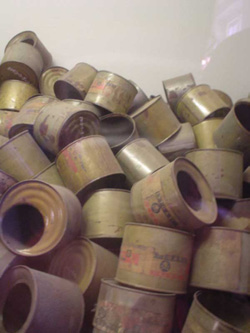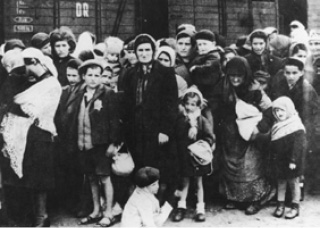Killing Factories
The Sonderkommando observed first-hand how killing became industrialized in the Nazi extermination camps. During 1942, murders were predominantly carried out at Treblinka, Sobibor and Belzec as part of Operation Reinhard, the initiative to murder the 2 million Jews within the Generalgouvernement.
Selections for labour at these three camps were sporadic and only occurred when the Nazis needed to renew the workforce: 99 per cent of those deported to Treblinka were killed within two hours of their arrival. Even those who were not immediately murdered were usually disposed of within a few weeks, as camp commandants wanted to eradicate anyone who might later testify as to what had taken place.
Under the deception that they had come to disinfection centres or transit camps, unsuspecting masses undressed and walked down camouflaged tunnels to their deaths. The lie about taking a shower misled thousands, who usually only realized they were inside a sealed gas chamber when they began to suffocate. Sobibor even had a mock train station with signposts and pretty flowers to purposefully give Jews on incoming transports a false sense of security. Maintaining a calm atmosphere enabled mass murder to be carried out with more efficiency than would have been feasible in an environment of widespread panic.
As at Chelmno, engine fumes were used to asphyxiate victims at Sobibor, Treblinka and Belzec. A total of 1.7 million Jews died at these three camps in 1942 and 1943, approximately 900,000 of them at Treblinka. Concurrently, the development of Auschwitz-Birkenau into the largest killing centre took place. The Little Red House and the Little White House had the capacity to gas 800 and 1,200 people respectively, but as deportations from wider Europe increased this was deemed insufficient. New gas chambers and crematoria facilities were designed and constructed, where in May 1944 a peak of 10,000 people a day would be killed and incinerated.
The murder process was deliberately developed to cause minimal stress to the Nazis, hence the delegation of the most gruesome tasks to the Sonderkommando. It was always an SS guard, however, who actually poured Zyklon-B crystals into the Birkenau gas chambers through an exterior hatch. Zyklon-B was originally used as a pesticide and the crystals gave off cyanide gas when they came into contact with air. Rudolf Höss, commandant of Auschwitz, later recalled that he knew when the gas had been effective because after around fifteen minutes, the desperate screams from within the chamber ceased. This killing method was also used at Majdanek, near Lublin.

Empty Zyklon-B canisters found in Auschwitz
It fell to the Sonderkommando to subsequently move and prepare the bodies for burial or cremation. This inhumane work involved the crude removal of hair, gold teeth and artificial limbs from the corpses, which were also intrusively searched for valuables. Everything appropriated, as with booty in Kanada, was meant to help the German war effort, but corruption was extensive and many Nazis profited personally from this desecration of the dead. Nevertheless, an estimated 60 million Reichsmarks were generated at Auschwitz alone for Hitler’s Reich.

Hungarian Jews arriving at Auschwitz, summer 1944 Bundesarchiv, Bild 183-N0827-318 / CC-BY-SA
While killing procedures subsided at the Operation Reinhard camps towards the end of 1943, the scale and pace of murder at Auschwitz accelerated in mid-1944, with the deportation of over 400,000 Hungarian Jews to the camp. Seventy-five per cent of these people were, on average, sent straight to the gas chambers. Summer 1944 also saw the liquidation of Birkenau’s so-called ‘Gypsy Camp’: of 21,000 Roma and Sinti who died in Auschwitz, the final 2,897 were killed in one night.
At all the extermination centres, the Sonderkommando initially buried the dead in pits. When it transpired that these were too shallow and the corpses began to putrefy, the Sonderkommando were forced to exhume the decomposing cadavers and unceremoniously burn them, simultaneously destroying evidence of mass murder. When the Auschwitz crematoria could no longer cope with the volume of bodies in the summer of 1944, the dead were also thrown into huge fire pits. Of an estimated 1.3 million people who entered Auschwitz, 1.1 million were annihilated. Approximately 90 per cent were Jewish.